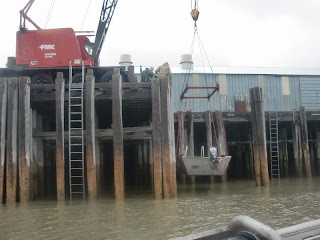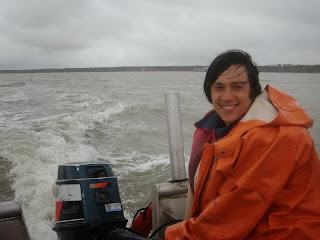Tuesday, June 3, 2014
June 2: First day of fishing (but not catching)
We got into town early today so we could get the first two skiffs launched and set the nets on the morning ebb. Like the other processors located on Naknek River, AGS has two levels. The top level, at the same level as the road, has the administrative offices, bunkhouses, most of the boat storage, net lockers and so on. The lower level, at the level of the river (or at least a crane's reach away from the river) is where the fish processing takes place, where the port engineer is, where the stock room is, and the warehouses. Two staircases connect the two as well as a sturdy but steep road. All manner of vehicle travel that curving road, including the big trucks carrying container vans and forklifts carrying all kinds of things. This morning, they carried our skiffs. The larger boats are moved to a trailer but our skiffs are small enough that the beach gang can put extended forks onto a forklift and pick them up. Then they have to drive down the hill backwards, keeping track of a hundred things at once as they navigate the sometimes narrow road carrying our precious skiffs. At one point on the road, the passage way is narrower than our 20' skiff, so the forklift driver must raise the skiff way up above the roof line of the buildings located along the road and keep a close watch on the skiff to make sure it remains stable, to the left and right to make sure it isn't about to hit something, behind to be sure he isn't about to run into someone. It's nerve-wracking to watch; I imagine it's even worse to do. This photo is of the skiff that has made its way down the hill and is in the slings though it is still being held by the forklift. After they get the slings on, they test it to be sure the load is balanced, then they lift it up and lower it into the water. This is the view from the dock, right in front of the crane, watching the boat going down. As soon as it hits the water - ideally the whole bottom hits at once - we climb down, get the outboard started, and make sure it will go forward and backward. A couple of the guys on the beach gang also go down and remove the slings while we back out. I am often so wound up about this whole process that I try to take the beach gang with me. I never get far, though. While they were lowering us, the Grayling was waiting, still on the forks. It wasn't the absolutely best weather to be launching boats - it was kind of moody, but the wind wasn't strong and that's the most important criterion. Jeff and I waited in the water for the Grayling to get down. Jeff was driving, leaving me to be the boat photographer. All went well with their launch – except that the sling caught on the life ring as David was backing the Grayling out into the river. You know, I’m not really a curmudgeon about regulations – well, not much, anyway. But it is aggravating when we are regulated to have so much safety equipment on board that it creates a hazard. We all wear life jackets – that’s my rule, not the coast guard’s. But we also have to have a life ring. These are small skiffs and we don’t have any place to store a life ring. Plus, we don’t really need it because no one is allowed to be in the skiff without a PFD (personal flotation device). But to avoid a ticket, we put the life ring inside the skiff and get our feet tangled in it, or hang it outside the skiff and get other stuff tangled in it. I think many good ideas have some unintended bad consequences.
After that small mishap, we got to the sites almost without any problems. Except two that left no scars. The water was a bit bumpy on the way out of the river and the gas tank fell off the seat onto its side, opposite the gas intake. It is an uneasy feeling when you know you have a full tank of gas, you're in the middle of a river miles from home, the first time out in 10 months, and the outboard begins to sputter and die. But looking toward the gas tank gave the answer pretty quickly. The other thing relates to the need for constant vigilance. The anchor line of the Bathtub is tied to the outside of the boat and stacked inside. Gravity pulls the line toward the water. That doesn't create any problem unless the water gets a hold of that line and pulls it out of the boat so it is trailing behind - undoubtedly making straight for the prop. Jeff was busy watching the water to be sure we didn't run over someone buoy or a big log, but he was very quick to respond when I lunged forward to grab the line and yelled, "neutral!" Here are David and Roger, running toward the shore trying to get out of the wind and waves. I thought they were just enjoying the fact that that 16' skiff is overpowered with the 45 hp outboard. But maybe when they were spinning around they were actually out of control. Eek! But it ended well.
Our initial plan was to arrive at the sites with the water low enough so that we could do a "walking set." That's when we attach the net to the outside buoy and then push the boat on foot toward the inside buoy, letting the net pop out of the boat as we walk. It is the most uneventful way to set a net and for that reason, my favorite way. But the tide wasn't low enough for that yet and the weather wasn't impossible, so we decided to practice a “deep water set,” the only choice left when the water is too deep for a walking set and we want to set the nets. A deep water set is difficult because we have a current and buoys that follow the current at the end of a 50' anchor line - actually, 2 - 50' anchor lines. When we’re setting out the net, it is always against the current and we always run the risk of getting the anchor lines and/or the web and/or the corkline or leadline tangled in the prop. That is a very bad thing, especially during a storm (which is typically when we’re trying to do this). This is particularly dangerous because tangling the prop renders us dead in the water and once we’re dead in the water, whatever has the outboard acts like an anchor line, which means that the boat is turned around so that the stern is facing the storm and taking the big waves (something it is not good at doing), while we are hanging off the stern and with mounting desperation trying to get the outboard untangled while remaining in the boat ourselves. It’s scary.
With relatively calm conditions, we decided to practice. We still had a problem with the current; we still ran out of gas in the middle of the set!; we still caught the prop in the anchor line (once) and the leadline (once) but no harm was done and we ended up successful– we got all three nets set (we didn’t set David’s because his permit has not yet arrived).
It takes a lot of energy to bring the boats down and set for the first time. We returned to the cabins and I prepared to head in to King Salmon to renew tabs and do other business while waiting for the tide to come back in so we could go through the nets. While at the DMV, the Physician’s Assistant from the clinic was also seeking to renew her tabs. She generously looked at my finger and warned that it had better get plenty better soon or they would have to do something that sounded like it would really hurt. (I took a big gouge out of it on Mother’s Day being careless, got 10 stitches to hold the pieces together and now I’m healing characteristically slowly.)
Before soaking that finger in Epsom salts, Roger, Jeff, and I went through the nets for the first time this season … waterhaul! Oh well, it's early and it turned into a beautiful afternoon and evening. Here, we are walking the skiff in because we want it easily accessible for the next tide, without rowing out to it.
Subscribe to:
Post Comments (Atom)









No comments:
Post a Comment